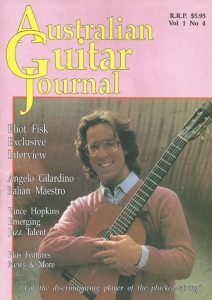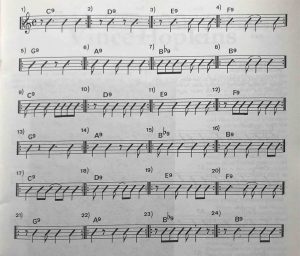
Improve Your Sight-Reading Skills!
By Bruce Clarke
Good sight readers have the ability to play almost any piece of music put in front of them, accurately, first time through. It’s a valuable skill, and one which anyone with a good basic understanding of reading can develop or improve.
Share this:
[feather_share]
There are three important factors which are essential for proficient sight-reading skill:
(1) Knowing how to “skim the part,”
(2) Recognition through repetition,
(3) Reading ahead. Let’s look at each one individually.
SKIMMING THE PART
Though sight reading means playing the part without ever having previously seen it, actually, between the time you’re first handed a new part and the first playing, there is usually sufficient time to look things over and check out the most important elements. This is known as “skimming the part.” It’s your opportunity to look for things like tempo markings, repeat signs, changes in time signature, changes in feel (i.e., Latin to swing), changes in equipment, special effects or important dynamic markings and key rhythmic figures, particularly those which may be difficult to play or appear written in an unorthodox manner. Depending on the length of the part, a skilled reader will skim through the part and be adequately prepared for the first playing in less than a minute. The key point to be made here is that you never want to be caught by surprise during the actual performance. If you’ve done a good job of skimming, you’ll know what’s coming before it comes, and that’s at least half the battle.
RECOGNITION THROUGH REPETITION
Assuming you’ve carefully skimmed your part and are fully aware of the melodic requirements, the next important factor is the accurate execution of the rhythmic figures on the part. The key word here recognition. Accurate recognition occurs only after figure or group of figures have been seen and play countless times. The mind tends to absorb and retain information which has been repeated time after time.
Many professional teachers claim that they developed accurate, high-speed sight-reading ability through the time spent reading simple basic material over and over again with their students, usually very slow tempos.
Below, you’ll find an assortment of 24 rhythm figures which are much used in jazz arrangements. Keep in mind that what you’re after is instant visual recognition followed, of course, by accurate execution. Begin by studying each figure without playing it. Absorb it into your mind’s eye. Then sing it aloud or yourself, as you continue to look at it. You can also try closing your eyes and singing the figure, while you mentally visualise what it looks like. Then begin to play each figure 50 or more times. Play slowly at deliberately, gradually increasing speed as you absorb each new rhythm.
Obviously, these 24 patterns are not the last word – any basic reading text that offers a selection of syncopated rhythms can be used to continue your study. As you practise each figure, remember that you are trying to establish instant recognition of the most common rhythmic figures and to develop the ability to see the sounds rather than the notes. By that, I mean hearing the figure as you look at it, as opposed to seeing a group of unrelated 8th notes, quarter notes, dots and rests. You accomplish this by way of constant repetition. The sooner you become adept at applying this concept, the sooner you’ll be on your way to improved sight reading.
READING AHEAD
The final step in improving your sight reading is cultivating your ability read ahead of what you are actually playing. If the eye is given the opportunity to see a rhythmic figure a split second before playing it, nine times out of ten, the correct message will be relayed to the hands.
Once you develop the ability to do this, you will limit the chances of being caught by surprise, which is the main reason why otherwise competent readers slip up.
To avoid being caught by surprise, you must learn to read ahead.
How far ahead? Slower tempos allow more time to grasp the figures before playing, so it’s not necessary to read as far ahead. However, as the tempo increases, so does the need to keep the eye further out in front of the hand. Though I have known of musicians capable of reading as far as one and a half to two bars ahead, suffice to say that even one-half to one full bar ahead will improve your sight reading considerably.
The four bars below offer a graphic example of the eye ahead of hand concept. Practice it slowly until you develop a knack for doing it.
Later, as you get better with the technique, you can increase the tempo and expand your eye movement.
The following 16-bar study can be used to further practise the technique.
Once you’ve gotten used to the idea, try it with other “rhythm” reading material. Also, be sure to incorporate the technique in all your sight-reading endeavours.
Remember, skim the part, learn to recognise as many rhythmic figures as possible, see sounds rather than notes, and read ahead. These are the key to improving your sight-reading skills.




